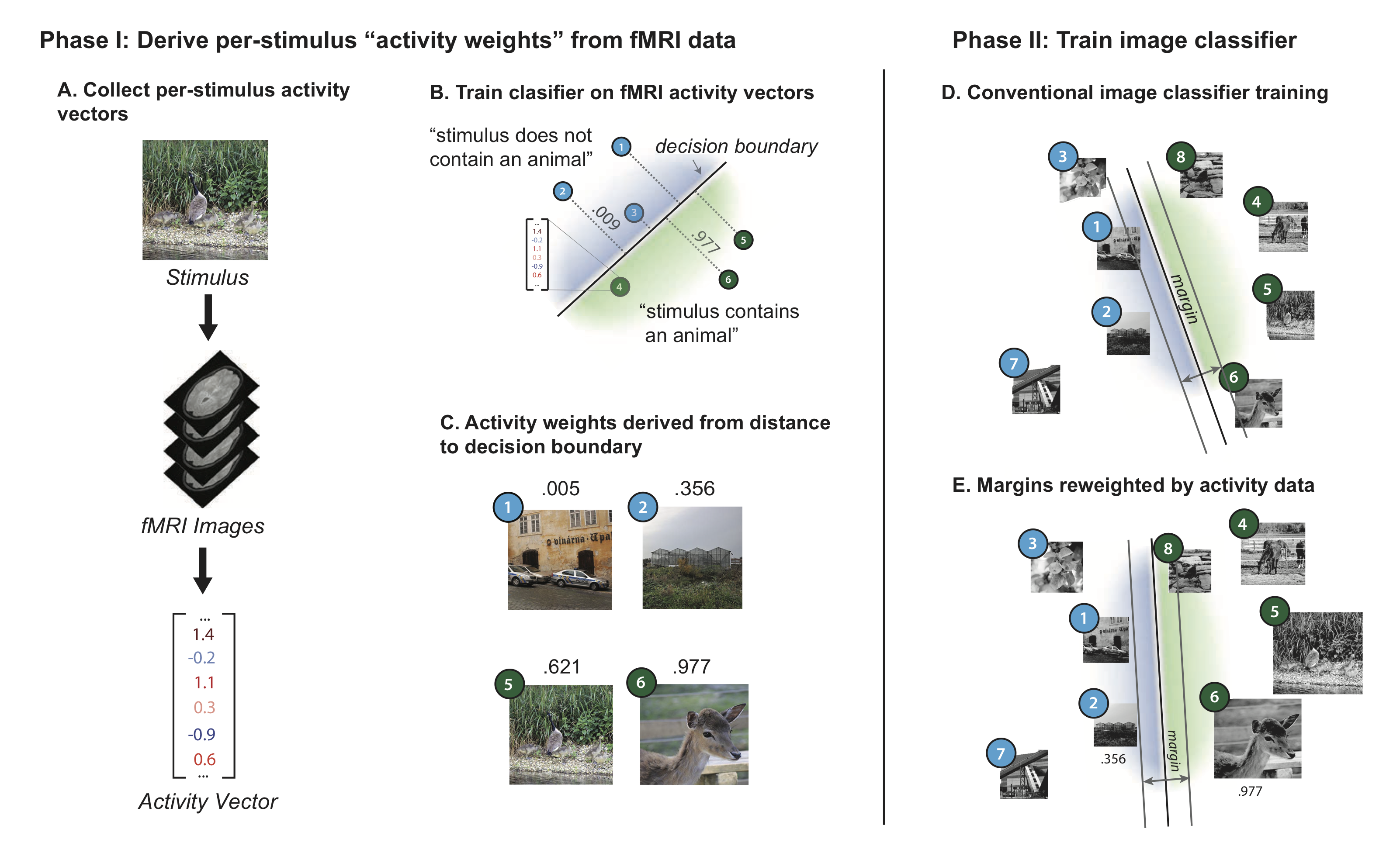Brain-informed Machine Learning
Fall 2014 - Spring 2019
Description
Machine learning is a field of computer science that builds algorithms that learn. In many cases, machine learning algorithms are used to recreate a human ability like adding a caption to a photo, driving a car, or playing a game. While the human brain has long served as a source of inspiration for machine learning, little effort has been made to directly use data collected from working brains as a guide for machine learning algorithms.
Here we demonstrate a new paradigm of "neurally-weighted" machine learning, which takes fMRI measurements of human brain activity from subjects viewing images, and infuses these data into the training process of an object recognition learning algorithm to make it more consistent with the human brain. After training, these neurally-weighted classifiers are able to classify images without requiring any additional neural data. We show that our neural-weighting approach can lead to large performance gains when used with traditional machine vision features, as well as to significant improvements with already high-performing convolutional neural network features. The effectiveness of this approach points to a path forward for a new class of hybrid machine learning algorithms which take both inspiration and direct constraints from neuronal data.
Further, neuroscience theory posits that the brain's visual system coarsely identifies broad object categories via neural activation patterns, with similar objects producing similar neural responses. Artificial neural networks also have internal activation behavior in response to stimuli. We hypothesize that networks exhibiting brain-like activation behavior will demonstrate brain-like characteristics, e.g., stronger generalization capabilities. In this work we introduce a human-model similarity (HMS) metric, which quantifies the similarity of human fMRI and network activation behavior. To calculate HMS, representational dissimilarity matrices (RDMs) are created as abstractions of activation behavior, measured by the correlations of activations to stimulus pairs. HMS is then the correlation between the fMRI RDM and the neural network RDM across all stimulus pairs. Our experiments show that networks with increased human-model similarity are correlated with better performance on two computer vision tasks: next frame prediction and object matching accuracy. An unexpected secondary finding is that the metric can be employed during training as an early-stopping mechanism.
This work was supported by IARPA contract #D16PC00002, NSF IIS Award #1409097, the Harvard College Research Program, and the NVIDIA Corporation
Publications
- "A Neurobiological Evaluation Metric for Neural Network Model Search,", , , ,
,Proceedings of the IEEE/CVF Conference on Computer Vision and Pattern Recognition (CVPR),June 2019.[pdf] [code][bibtex]@InProceedings{Blanchard19,
author = {Nathaniel Blanchard and
Jeffery Kinnison and
Brandon RichardWebster and
Pouya Bashivan and
Walter J. Scheirer},
title = {A Neurobiological Evaluation Metric for Neural Network Model Search},
booktitle = {IEEE/CVF Conference on Computer Vision and Pattern Recognition (CVPR)},
year = {2019},
}
- "Using Human Brain Activity to Guide Machine Learning,", , ,Scientific Reports,March 2018.[pdf] [supp. material][bibtex]@article{fong2018using,
title={Using human brain activity to guide machine learning},
author={Fong, Ruth C and Scheirer, Walter J and Cox, David D},
journal={Scientific reports},
volume={8},
number={5397},
year={2018},
publisher={Nature Publishing Group}
} - "Perceptual Annotation: Measuring Human Vision to Improve Computer Vision,", , ,IEEE Transactions on Pattern Analysis and Machine Intelligence (T-PAMI),August 2014.[pdf][bibtex]@article{Scheirer_2014_TPAMI,
author = {Walter J. Scheirer and Samuel E. Anthony and Ken Nakayama and David D. Cox},
title = {Perceptual Annotation: Measuring Human Vision to Improve Computer Vision},
journal = {IEEE Transactions on Pattern Analysis and Machine Intelligence (T-PAMI)},
volume = {36},
issue = {8},
month = {August},
year = {2014}
}
Press Coverage
- New Scientist Magazine: "MRI Brain Scans Train Machines to See the World More Like Us"
